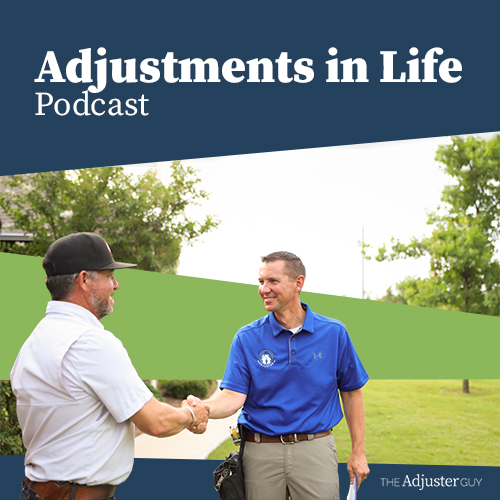https://podcasts.apple.com/us/podcast/adjustments-in-life-podcast/id1536156585?i=1000511795506
Links
Timothy Etheridge on LinkedIn: https://www.linkedin.com/in/timothy-etheridge-9b930672
Transcript
Alan: Alright! Thank you for joining the podcast today. I have a really special guest today. I’ve had a lot of privilege by being able to work with this gentleman—not only as an adjuster, but on the management side as well.
So I want to welcome onto the podcast Mr. Timothy Etheridge of Alacrity Solutions. Tim thanks for joining!
Tim: You are quite welcome sir.
Alan: Alright so I stress a lot on this program the importance of relationships and keeping those relationships. And that’s been something I’ve been able to do with Tim as we’ve worked together through the years.
I stepped out of the management side of adjusting and went back into the field. And I maintained a relationship with Tim—working under him.
So I just want—before we get too much into this—I just want to say thank you Tim for working with me as much as helping me. I feel like I owe a debt of gratitude to you for the relationship we have been able to acquire together. So I just don’t want that to go without being said.
So, who’s Timothy Etheridge?
Tim: Now as you mentioned, I am one of the senior client managers with Alacrity Solutions. My current role is overseeing the catastrophe property claims on the USAA account—which I’m very fortunate to have that account.
This account includes not only myself, but I also have a senior field manager, also five full time regional field managers and up to five additional temporary managers at any given time—especially during peak times when storm seasons are around.
And we normally manage anywhere from 250 to 350 or more field adjusters at any given time.
Alan: Wow! That’s a group to have to tend to on a daily basis. I’m positive that my teams that I worked on weren’t near that massive. And I know your role is kinda being over everybody. Am I correct on that?
Tim: You are correct. It’s very trying at times.
Alan: Where in the chain—other than total client manager—if an adjuster out in the field is having trouble, are you the guy to come to or who in that chain is that person going to be dealing with?
Tim: Good question! So the basic chain of command goes like this—the adjuster, if they have a question, would typically go to their assigned regional field manager. Now, if the regional field manager can’t answer that question, then he in turn should bump it up to the senior field manager and, at that point, if the senior field manager has any issues, questions, or concerns, then it will be bubbled up to myself at that point.
Alan: Gotcha. So in other words, for the new adjusters who are listening, if you get the chance to work on the USAA account, take this insight—this is only going to earn you more credibility as you experience and learn in the adjusting field by understanding the chain of command.
And I’m sure it doesn’t stay in USAA, this works into the other clients as well. But understanding your chain of command and the people who are above you and who they have to answer to is extremely crucial to how they look at you.
As a new adjuster, you don’t want to be the guy that just came on and calling Tim in the middle of the evening trying to get answers of what they want you to do on a particular claim.
So that’s good. I appreciate that.
What did you do before you got into this? I know for me, I came from construction and I think that probably 80 percent of the adjusters out there—that get into this—probably worked somewhere around the construction trade.
But, where did you start? What brought you into this?
Tim: Now oddly enough, I didn’t even know what an adjuster was before entering into the adjusting world. Prior to being a property adjuster, I was in commercial construction; but in between the construction phase and adjusting, I was in a totally different field for ten years.
Believe it or not, I was in law enforcement. I was a sergeant investigator and a K9 handler for the narcotics task force here in East Texas. So I basically went from a high intensity, high stress job of kicking in doors and chasing criminals to actually having to knock on the doors and climbing on the roofs.
I had a friend who mentioned he was an adjuster, and he kept telling me these wild stories of how he made 120 thousand dollars a year and only had to work six months out of the year.
Obviously, I was intrigued by that, and I asked him what does an adjuster do. He explained how easy it was—just go out, look at the damages from the storm, and then just tell the insurance how much it would cost for repairs.
That sounded easy enough. So in 2001, I finally decided to give it a shot. I took a week off from the narcotics task force and went to a five-day adjuster school that the NCA was hosting in Indiana of all places.
From there, I was actually offered a chance to go for two days to KAnsas City, Missouri to work a handful of hail claims, so I decided to take a few more days off from the task force and try my hand at adjusting.
So basically two days turned into two years in Kansas City, and the rest is pretty much history. Here we are today.
Alan: So Alacrity Solutions now is a remnant of NCA group?
Tim: Correct.
Alan: So basically—and I’m just speaking in terms of everywhere I’ve seen and who I’ve met—you’ve worked for one company pretty much, well, all of your career.
Tim: True! I never strayed.
Alan: That’s an achievement of its own. You don’t find that very often. I know, we all try to find that place we call home as adjusters—we want to work for the same firm. I know I try to do that—it’s worked somewhat for me.
I think we all do find that place we call home, but home doesn’t always have what it takes to survive. So we kinda have to outsource here once in a while in order to keep putting food on the table.
So in those years from then ‘til now, can you kinda explain some of the ranks you’ve gone up? Have you worked multiple accounts? Have you managed multiple accounts? How does that story kinda layout?
Tim: Yes, I was the normal adjuster for almost ten years with, again, what you say would be the NCA group. They kept offering me a position in management, so I finally decided to take the position in management.
I started off with a smaller account up in the northeast just managing just a few adjusters. It was just me by myself. From there, I kinda transitioned on to another larger account which was Nationwide, and I was managing Nationwide and that was also a very good account to manage.
Then the opportunity for me to manage the USAA account—which I definitely jumped at this opportunity because I do love managing this account.
So I was still considered a team resource to begin with until later on. Then I finally transitioned up to what is called a claims manager and then from a claims manager to a client manager.
The last two years we transitioned from a client manager to a single client manager on the. Larger accounts that we have.
Alan: Where all—can you give us some idea—gosh, I’ve travelled all over the place, and—more places than i ever really dreamed I’d get to go, i got to work Philadelphia over the Fourth of July—take my kids to see the Liberty Bell—there’s an amazing amount of places you get to go.
What are some of the places that you went and what were the most memorable places that you got to go or where this career took you?
Tim: Oh wow! Yes, before going into adjusting, I didn’t travel very much at all. I stayed pretty much in Texas. After becoming an adjuster, I had the opportunity to do quite a bit of traveling with the adjusting business.
Now, my daughter was actually born in Kansas City, Missouri; but she wasn’t very old when we moved back to Texas. But she was definitely an experienced traveler by the age of five for sure.
When she was three, we were in Blue Springs, Missouri for almost a year; and then it turned out she actually went to pre-k in Saint Cloud, Minnesota, because we were also up there for about a year.
Then we finally settled back down in Texas for the remainder of her education.
But I’ve also had the opportunity to travel to Durango, Colorado back in 2002 to work the wildfires—that was definitely memorable. I’ve also been to Alaska on three separate occasions to work claims, and also been to Hawaii on eight different occasions to handle claims. Those were definitely memorable.
But again, there are just too many to mention thus far as being memorable because you get to travel a lot with this job.
Alan: Yeah I’ve been really pleased with all the places—although, well you and I both know I passed on Alaska once, and I’ve been kicking myself in the rear ever since. But, I have not been privileged enough to have Hawaii—and honestly, I hear horror stories and sometimes people are happy.
I really don’t care about the work; I just want a trip to Hawaii! If I don’t make any money on that trip, that’s okay with me. I can live with that.
So it just popped into my head and I know—as people get into this business—if they get the opportunity to work for Alacrity—and especially with USAA account—I’ve just got to give everybody a bit of a warning, because you are kinda known as the prankster amounts the managers.
I have to tell a quick story because when I first transitioned into the management field, I was asked to go help on theLiberty Mutual account. Of course, that was the account I had primarily been working at, so I knew all the managers really well.
The particular storm that I got deployed as a manager on, turned out not to be a very big producing storm for claims. So the Vice President of the Claims asked me if I would go help on the USAA account. I knew nothing about the guidelines that the USAA account engulfed for adjusters.
So I get this phone call that says ‘here we need you over there more so than Liberty Mutual, so why don’t you give this guy—Tim Etheridge—a call and he’ll fill you in on all the particulars for USAA and you’ll be fine—just give him a call and head down to help them out.
And so I’m on my way to assist in management in an account I don’t even know—I’ve never worked before. And I call Tim, and Tim is supposed to be the guru.
Well, I didn’t—I knew that he was a manager on there, but I didn’t know how long he’d been managing. But either way, he’s supposed to be the guy that gives me all the insight.
So I call him on the phone, and he answers. I explain who I am, and he says ‘Oh, okay.’
I say, “I’m supposed to call you to get some insight on managing USAA.”
And the phone gets really quaint and all of a sudden I hear ‘Oh, is that account with army people or something?’
And for about three minutes I’m sitting on the phone going, ‘is this guy even an adjuster? Does he know anything about this? ‘Cause he acts like he knows nothing.”
I get off the phone. You kinda cracked up and started laughing a little bit about that, but I got off the phone and called Jody Beer—and of course, Jody Beer fell off the phone laughing. And you know you gotta expect that from Tim—that’s just the kind of guy TIm is.
And then, of course—it wasn’t a year and a half, two years later— that we worked together in a help room in Fort Worth, Texas; and I go out to assist on a ride along and come in and find that my computer screen is upside down as well as when i try to log in, it makes sounds as if I’m passing gas through the help room.
So I do have to give those who are listening a bit of a warning that—should you get the opportunity to work with or around Tim—DO NOT leave your equipment unattended around Tim. If you do, it’s likely that it won’t work the same when you come back as it did when you walked away from it.
Tim: Fair warning.
Alan: Not to be a spoiler, but—unless you welcome it. And sometimes I do think we welcome them—you know, it breaks up the monotony and let’s us have a bit of fun.
So, one of the things I wanted to ask you—the claims industry today—is totally different then what it was when you started. And constantly, people are asking where it is going—what’s it doing? I mean it is an ever changing industry.
So, in your eyes, the way you look at it, how has it evolved and how—in today’s world—what does it take to be a good adjuster in today’s industry?
Tim: Oh wow! Yes, the industry has definitely evolved in the short 19 years that I’ve been in the adjusting business. When I started, we had to print out our reports and the photos—of course a lot of ink, a lot of paper. We had to staple everything together, then we had to drive to the office so a manager could review everything.
Then he would take it and look at it. He’d take a red pen and mark up revisions that need to be done. He’d mark all of them up; then he’d had them back to us. Wed travel back to our hotel rooms, make the revisions, and print everything back out,, then travel back to the office and turn everything back in.
Well obviously now all of that’s changed. It’s a whole lot easier now since everything we do now is sent electronically—online.
But as you mentioned, the requirements have also changed for today’s adjuster as opposed to adjusters 20 years ago. We now live in a world now where, due to advancements in technology, everyone wants instant gratification. That’s the way the world is today.
Whether it pertains to shopping or any service of any kind—based on that current mindset, insurance companies are now more focused on customer satisfaction and how quickly they can get a payment into an insured’s hands. And obviously, that makes much more sense for a business in order to improve customer satisfaction.
So, where we used to be handed 100 losses and told to just get them in when we can—or when we could—today’s adjusters may only receive 25 to 30 losses at the very beginning of a storm so that their average turnaround time is going to be quicker.
And there’s problems with adjusting where I guess an okay file was okay—you might have three or four line items and maybe ten photos and again, like I said, that was okay. But in today’s world that okay file is no longer acceptable—quality is now a mega focus for all major insurance companies as well as most adjusting firms—they also want to see that good quality.
Alan: Yeah, exactly. I agree with you 100 percent, and i mean i know, speaking for me, i think i have more than 50 or 60 photos typically on a claim they may not have any damage. And I think you can agree, in that case, those are in their to prove that we didn’t find any damage.
And I think there was a time when you didn’t have to prove when there wasn’t any damage, you just had to prove that you did have damage, is that correct?
Tim: Absolutely. That is definitely the normal of today’s files. It’s just as equally important to prove that you have no damage—and normally that does require more photographs than if you actually had damage.
Alan: Yeah, and I’m probably one of the first ones to admit that complains a lot about when we start looking at the documentation that is needed. I mean, gosh! We put together a long list of—they say when you put your loss report together, we’re not writing a novel, we’re just telling the facts.
But sometimes it can take a short novel to get all those facts in there. And I may not be that big of a claim. Real quick, before we get off of this subject, how much would you stress that? Because anybody who comes to me for help and assistance in learning how to do this, the biggest thing I can give them constantly is the importance of documentation.
Tim: Correct. And again, me coming from a law enforcement background, documentation was very important. And that’s also what I brought over into adjusting.
Documentation is the most important thing that we have because, as we always hear, if it’s not already in file, it didn’t happen..
Alan: That’s right. You know, I spent a real short time on the management side compared to what you’ve done, so I do see that perspective. So I know where that lack is and in all honesty, across the spectrum, there is a huge lack. I think that’s something that could—even though there is more requirement when we start doing these claims—but I think that there is a potential for today’s adjusters to excel in that more so than what they’re doing.
They’re not putting that documentation into it that they could be—for the fact that it becomes work. But I feel that it’s really important to teach these new adjusters—especially a lot of the listeners on this podcast will probably be brand new or more relatively new to the trade—to hear it come out of your guy’s mouth, speaks bounds.
I can tell them and tell them and they’ll tell them that people are actually going to be looking at their files—I’m not going to be reviewing their files, but you might—so would you say that to them and express the importance, I think can go a long way.
Tim: I definitely agree. And probably the most common question you hear from the newer adjuster also is “How many photos does it take to properly document a file?” There’s never a set number, it’s just how many it takes to adequately document the damage or lack of damage.
Alan: So in the eyes of Timothy Etheridge, when you look at somebody, what are the qualities you’re looking for to say, now that’s a good adjuster?
Tim: Okay, so what does make a good adjuster? So, in my perspective, I like to do what I call the 5 A’s of adjusting.
So the first one would be ABSORB—as a newer adjuster, you want to absorb as much as possible from your instructors in the classroom, wirtual, in person—whatever it may be—your assigned team lead managers, as well as anyone you might know is a successful adjuster.
The second one is ACCEPT. So you’ve got to accept constructive criticism from others—whether it be another adjuster who is successful, whether it’s going again to be your instructors or your teammates—you’ve got to accept constructive criticism and learn from that.
The third A is ADAPT. You’ve got to be able to adapt to ever changing guidelines, situations—whatever the situation may be. That’s another major factor of being a good adjuster.
Alan: Absolutely.
Tim: The fourth A is ATTENTION. You’ve got to be attentive. You’ve got to be attentive to your managers, you’ve got to be attentive again to your instructors, you’ve also got to be attentive to that insurer—that member—that entails listening and showing interest and sympathy to the insured. That’s another key point to being an adjuster.
Now the fifth, and one that I think is one of the most important A’s of adjusting is ATTITUDE. Always maintain a positive attitude can make a world of difference in adjusting. As long as you maintain a positive attitude and are willing to learn and your willing to listen to that insured or that member from wherever they’re telling you that story and you’re having the patience to sit there and listen to there story and act like it’s the first time you’ve seen that hailstone, then that’s going to make a world of difference to you and the the adjusting world.
Alan: I couldn’t agree more. As you were explaining these things, I think—and you can correct me if I’m wrong—I think these qualities, I don’t think you have to be experienced to obtain these qualities. I think these are something you can have that a brand new adjuster that just got his license out on his first deployment can express these qualities to you. Is that correct?
Tim: That is correct.
Alan: I’m listening to you explain this and I’m going ‘that doesn’t take years of experience—pieces of it can—but the overall the 5 A’s that I’m looking at—that I’m hearing you talk about—that just has to be something that you as a manager can see that you’re willing to work with. You’re taking these things without even knowing it, they could being taking these things and expressing them.
So based off of what you are telling me, you could say that’s a good adjuster right there—or they’re going to be a good adjuster. Again, those that are listening, this is top notch information right here. If you can implement these things into what you are doing, you are going to draw in the eyes of the managers and those are the guys that are going to keep you out in the field when you want to be working.
Okay, man this is good stuff. I really appreciate you laying that out there, because the more ears hear this could make a huge impact on the incoming adjusters. And there’s always a need for incoming adjusters, so those that are getting this information if they’re willing to implement it and put it to work in their lives, could make a big impact.
So really the last thing that I wanted to ask you—because I ask this to everybody, mostly because I want to know where they are coming from because I know I was given very valuable advice and thank God, I was willing to listen to some of the things I was told. I didn’t always follow them I guess as good as I should have, but I can look back now and say ‘hey some of the most simple things that people told me—when I listened to them—made the biggest impact on what I do.
So if there was ever a solid piece of advice that was given to you—that stood out in your life—what is that piece of advice? And then how did that contribute to your success?
Tim: Okay, so possibly one of the best pieces of advice I ever received came from my very first storm manager—a guy by the name of John Wheety. He told me that it’s not so much as how you arrive at a storm and how good you were when you arrived that will be remembered, it will be how good you were the day you leave the storm is what will be remembered the most.
And that saying can be interpreted many ways whether it pertains to your productivity, your file quality, your attitude, communication—that pertains to almost anything and everything that has to do with adjusting. And that has stuck with me for, again, almost 19 years that I’ve been in this business and I still try to preach that to each and everyone that I come across.
Alan: Well, man that’s good—that’s solid. I think that that’s something that you’re exactly right on. I mean gosh! It’s so true. When you walk off of that sight, the last thing they will remember about you will be what you carry with you. So man, good stuff, solid information.
Well Tim man, I really appreciate you joining me today. I think the listeners are going to get some good insight out of this and hopefully implement it in ways. I hope that everybody listening here gets the chance at some point in their career to work with Tim. He’s a really awesome guy to work with.
I’ve been very privileged to have had the relationship with him that I have and the relationship that we have will continue on—I’m positive of that.
So again Tim thanks for joining. I hope everybody got some good information today. As I said, this is good stuff. Good managers will carry you a long way in this business. So do as they ask, focus on the things that they need, and leave that good impression. Leave the impression that the day you leave, they want you to come back. Remember the 5 A’s.
Any last words?
Tim: No, thank you for allowing me the opportunity. It was certainly a pleasure and the feeling is mutual.
Alan: Alright well hopefully we can do this again not too long from now and kinda keep things updated and keep joining together on this.
Thanks again folks, and we will see you down the road.





